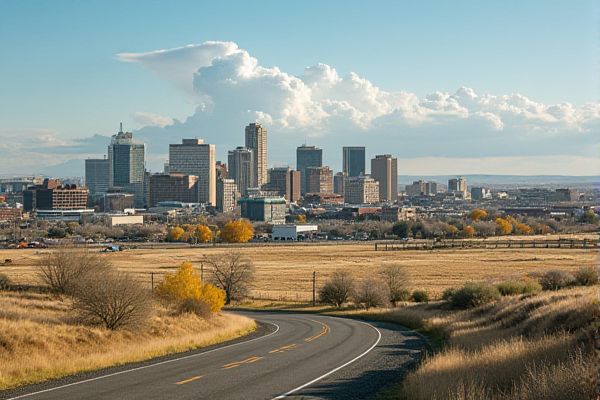
Transportation and commuting in Wyoming: Limited public transportation options available. Private vehicle ownership is common. Roads can be affected by weather conditions. Few rideshare services in rural areas. Snow tires recommended during winter months. Regularly maintain vehicles for long-distance travel. New commuter rail projects are rare. Hitchhiking is prohibited on interstate highways. Roadway service stations are sporadic. Highway map apps are essential for navigation.
Limited public transportation options available.
Public transportation in Wyoming is limited, with few options available outside of major towns. While cities like Jackson have systems like the START Bus, many communities rely on private taxis, Uber, or personal vehicles, and accessing remote areas without a car is challenging. For more information on public transportation resources, visit the Wyoming Social Resources website.
Private vehicle ownership is common.
In Wyoming, private vehicle ownership is extremely common, with 148 vehicles registered per 100 residents, making it the second-highest rate in the nation after Montana. This high rate of vehicle ownership reflects the reliance on personal vehicles for transportation in the state. For more detailed insights into vehicle ownership statistics, you can visit the ValuePenguin website.
Roads can be affected by weather conditions.
In Wyoming, roads can be significantly affected by weather conditions, with reports indicating various impacts such as dry conditions, slick spots, strong winds, and seasonal closures due to snow and ice, necessitating extra caution and regular checks on Wyoroad conditions.
Few rideshare services in rural areas.
Rural areas in Wyoming, characterized by low development densities, often have limited demand for alternative transportation modes, including ridesharing services. This is primarily due to their automobile-dependent nature and the economies of scale required for viable public transit and ridesharing options. For more information on these dynamics, you can explore the concept of Transportation Demand Management and its applications in such regions.
Snow tires recommended during winter months.
Snow tires are highly recommended for winter driving in Wyoming, especially in areas with heavy snowfall and higher elevations. They provide superior traction and safety in snowy and icy conditions, making them an essential consideration for any driver in the region. Whether you're navigating through a blizzard in the mountain passes or dealing with icy roads in the valleys, having the right tires can significantly enhance your vehicle's performance and safety. For more detailed guidance on winter driving in Wyoming, the Cowboy State Daily provides expert tips and recommendations to ensure you are prepared for the harsh weather conditions.
Regularly maintain vehicles for long-distance travel.
To maintain vehicles for long-distance travel in Wyoming, it is crucial to follow regular maintenance tips such as changing the oil at recommended intervals, replacing antifreeze every three years, fixing cooling system leaks promptly, keeping the engine properly tuned, and using high-quality fuel and fuel conditioners. These steps are essential for ensuring your vehicle remains reliable on the open road. To delve deeper into these practices, you can visit the article on how to keep your Wyoming vehicle on the road longer, which provides comprehensive insights and guidance.
New commuter rail projects are rare.
New commuter rail projects in Wyoming are gaining traction, with potential lines connecting Laramie and Cheyenne to Fort Collins, Denver, and other regions. These initiatives are supported by federal funding and ongoing studies conducted by the Federal Railroad Administration and local advocacy groups. This development represents a significant step forward in improving regional connectivity and transportation efficiency.
Hitchhiking is prohibited on interstate highways.
In Wyoming, while hitchhiking is legal, it is generally prohibited on interstate highways themselves, although enforcement varies. Hitchhikers can often stand at on-ramps without significant issues. For comprehensive details, you can visit the Hitchwiki page about the United States of America, which provides an extensive overview of hitchhiking regulations across different states, ensuring travelers are informed about local laws and practices.
Roadway service stations are sporadic.
In Wyoming, the roadway system is characterized by a significant portion of major roads being in poor or mediocre condition. With 14% of major roads and 7% of bridges rated as poor or structurally deficient, this can contribute to the sporadic availability and necessity of service stations. This is particularly crucial given the vast and often remote nature of the state's road network. For a comprehensive understanding of these issues and their implications, you can refer to the TRIP Fact Sheet, which provides detailed insights into Wyoming's transportation infrastructure challenges.
Highway map apps are essential for navigation.
The Wyoming 511 app, developed by the Wyoming Department of Transportation, is a crucial tool for navigation, providing pre-trip map-based road and traffic conditions, web camera images, and real-time updates on road conditions, weather, and traffic incidents. The app also includes hands-free and eyes-free features to ensure safe driving. To explore more about this essential navigation tool, visit the Wyoming 511 website for comprehensive information.
